
Volume 3, January 2012
|
||||||||||||||||||||||||||||||||||||||||||||||||||||||||||||||||||||||||||||||||||||||||||||||||||||||||||||||||||||||||||||||||||||||||||||||||||||||||||||||||||||||||||||||||||||||||||||||||||||||||||||||||||||||||||||||||||||||||||||||||||||||||||||||||||||||||||||||||||||||||||||||||||||||||||||||||||||||||||||||||||||||||||||||||||||||||||||||||||||||||||||||||||||||||||||||||||||||||||||||||||||||||||||||||||||||||||||||
| AR | So, Maestro, in the Divertimento, all the modifications that we note on your score were made before Rota's death or after? |
| FP | After his death I changed nothing. Everything was accepted or suggested by the Maestro. Also in the concerto by H. W. Henze, I made numerous modifications, but only with his consent. He wrote on my score, "the corrections made by Franco Petracchi are not only accepted by me, but also desired, because they are done with reason." The same with the music of Rota.86 |
3.2 — The Revisions after the Publication
This portion of the chapter is directly concerned with the revisions that were made to the Divertimento after its publication in 1973. In each of the charts to follow, excerpts from the published version will appear on the left and top, and excerpts from the later revision on the right and bottom. Both sources were described in Chapter One. The revision charts place the quoted excerpts in their order of appearance in the Divertimento, movement by movement. The revisions tabulated in this chapter fall into one or more of the following categories:
1 — Tempo markings (including fermatas, rallentandos, etc.)
2 — Note alterations, additions, and deletions
3 — Rhythmic alterations
4 — Register alterations
5 — Revisions of articulation and dynamic markings
6 — Revisions of terms, titles, and special markings (e.g., repeat markings, etc.)
My main intention is to provide performers with a detailed list of all the passages that have undergone significant alterations from their original form. Another set of less significant revisions, e.g., changes in articulation and dynamic markings, have been listed in Appendix B. At the end of this chapter a summary of the most significant revisions will be provided. The revisions given at the right and at the bottom of each chart reproduce both the printed changes in Petracchi's computer-generated score and any further handwritten changes, e.g., fingerings and bowings that appear on his personal copy. As a result, the reader will have access to all stages of the revision process involving either Rota, Petracchi, or both. For the sake of clarity, each pair of musical examples has been placed in its own Revision Chart, followed in most cases by an explanatory comment.
3.2.1 — Allegro
Revision Chart 1
| Category of revision: Category of revision: Revisions of terms, titles, and special markings (e.g., repeat markings, etc.) | |
| Location in score: Location in score: Title page | |
| 1973 Edition | Revised Version |
 |
 |
Explanatory comment: In this revision the title name for the first movement has been changed from Allegro to Entrata.
Revision Chart 2
| Category of revision: Tempo markings | |
| Location in score: Title page, beginning of the Allegro | |
| 1973 Edition | Revised Version |
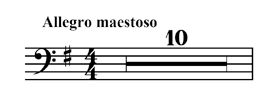 |
 |
Explanatory comment: The metronome marking of quarter-note equals 120 has been added next to Allegro maestoso.
Revision Chart 3
| Category of revision: Tempo markings and revisions of articulation and dynamic markings | |
| Location in score: Allegro maestoso, 2 and 3 mm. after RN 5 | |
| 1973 Edition | Revised Version |
 |
 |
Explanatory comment: The tempo marking has changed from the initial Allegro maestoso to a Lento in which a metronome marking of quarter-note equals 60 has been added, the added word Movendo dictates a gradual acceleration. A down bow marking, an articulation marking (detaché), and fingerings have also been added to the part.
Revision Chart 4
| Category of revision: Tempo markings, note alterations, additions, and deletions, and revisions of articulation and dynamic markings | |
| Location in score: Allegro maestoso, 4 and 5 mm. after RN 5 | |
| 1973 Edition | Revised Version |
 |
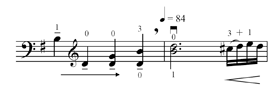 |
Explanatory comment: Here a metronome marking of quarter-note equals 84 has been added at 5 mm. after RN 5, as well as an arrow at 4 mm. after RN 5, signifying that the music will gradually accelerate. In addition, two notes have been deleted, a D-natural on beat 1 and a G-natural on beat 2 of 4 mm. after RN 5. A down bow marking, an articulation marking (detaché), as well as fingerings have also been added to the part. Note that a comma has also been added at the end of the measure 4 mm. after RN 5. Finally, the articulation marking marc. (marcato) has been removed in the revised version.
Revision Chart 5
| Category of revision: Tempo markings and revisions of articulation and dynamic markings | |
| Location in score: Allegro maestoso, 3 mm. before RN 6 | |
| 1973 Edition | Revised Version |
 |
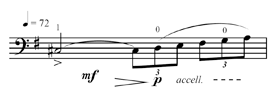 |
Explanatory comment: In this revision a metronome marking of quarter-note equals 72 has been added 3 mm. before RN 6, as well as an accell . . . (accelerando) marking. An accent marking (>) on the C-sharp on beat 1, as well as fingerings have also been added to the part. Notice that the dynamics are also revised: the mf is moved to the end of beat 1, a diminuendo marking is added from beat 2 to beat 3, and a p marking has been added at the second eighth-note triplet in beat 3.
Revision Chart 6
| Category of revision: Tempo markings and revisions of articulation and dynamic markings | |
| Location in score: Allegro maestoso, 1 m. before RN 6 | |
| 1973 Edition | Revised Version |
 |
 |
Explanatory comment: Here an accell . . . (accelerando) marking has been added at 1 m. before RN 6. Accent markings (>) have been added on the last four sixteenth-notes of the measure. Note that the slur over the last four notes of the measure in the revised version has been removed. Fingerings are also added to the revised version.
Revision Chart 7
| Category of revision: Tempo markings and revisions of articulation and dynamic markings | |
| Location in score: Allegro maestoso, at RN 6 | |
| 1973 Edition | Revised Version |
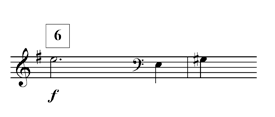 |
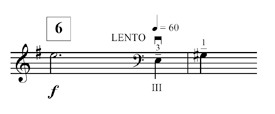 |
Explanatory comment: In this revision the tempo marking Lento has been added (quarter-note equals 60), which is a change from the previous tempo marking of quarter-note equals 72 at 3 mm. before RN 6. A down bow marking (on E-natural), articulation mark (detaché), as well as fingerings are added to the revised version.
Revision Chart 8
| Category of revision: Tempo markings and revisions of articulation and dynamic markings | |
| Location in score: Allegro maestoso, 3 and 4 mm. after RN 6 | |
| 1973 Edition | Revised Version |
 |
 |
Explanatory comment: In this revision a metronome marking of quarter-note equals 84 has been added at 4 mm. after RN 6, as well as an arrow in 3 mm. after RN 6. A down bow marking, articulation markings (detaché), and fingerings have been added to the revised version. A comma has been added at the end of 3 mm. after RN 6. The articulation marking marc. (marcato) has been removed in the revised version and a crescendo marking has been added in beat 4 of 4 mm. after RN 6.
Revision Chart 9
| Category of revision: Tempo markings and revisions of articulation and dynamic markings | |
| Location in score: Allegro maestoso, 3 mm. before RN 7 | |
| 1973 Edition | Revised Version |
 |
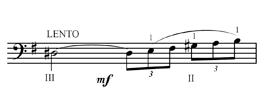 |
Explanatory comment: Here the tempo marking Lento has been added, which is a change from the previous tempo marking of quarter-note equals 84 at 4 mm. after RN 6. The mf in beat 3 has been moved to beat 2. Fingerings have also been added to the revised version.
Revision Chart 10
| Category of revision: Tempo markings |
| Location in score: Allegro maestoso, 3 mm. before RN 7 |
| 1973 Edition |
 |
| Revised Version |
 |
Explanatory comment: In this revision two accell . . . (accelerando) markings have been added, in beat 3 at 2 mm. before RN 7, and at the beginning at 1 m. before RN 7. In addition, note that the slur over the last four notes of 1 m. before RN 7 has been removed and fingerings have been added.
Revision Chart 11
| Category of revision: Tempo markings | |
| Location in score: Allegro maestoso, RN 7 | |
| 1973 Edition | Revised Version |
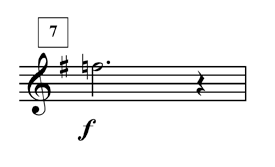 |
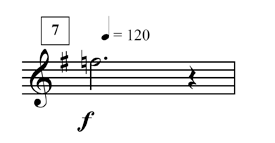 |
Explanatory comment: The tempo marking of quarter-note equals 120 has been added, which is a change from the previous tempo marking Lento, given at 3 mm. before RN 7.
Revision Chart 12
| Category of revision: Tempo markings, note alterations, additions, and deletions, rhythmic alteration, register alteration, revisions of articulation and dynamic markings |
| Location in score: Allegro maestoso, 1 m. before RN 8 to RN 8 |
| 1973 Edition |
 |
| Revised Version |
 |
Explanatory comment: in this revision all the categories of revisions are present. At 1 m. before RN 8 on beat 1, three of four sixteenth-notes were removed (E-flat, D, and E-flat); in the same beat the first sixteenth-note (D) was changed to an eighth-note. In addition, an accent is added on the D-natural down beat of 1 m. before RN 8. From beat 2 of 1 m. before RN 8 to RN 8, the entire descending line has been displaced one octave higher, with staccato articulation on the sixteenth-notes on beat 2, and with slurs added on beats 3 and 4 of 1 m. before RN 8. Finally, at RN 8 a tempo marking of quarter-note equals 132 has been added to increase the previous tempo marking of quarter-note equals 120, given at RN 7.
Revision Chart 13
| Category of revision: Note alterations, additions, and deletions, and revisions of articulation and dynamic markings | |
| Location in score: Allegro maestoso, RN 11 | |
| 1973 Edition | Revised Version |
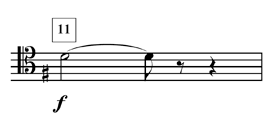 |
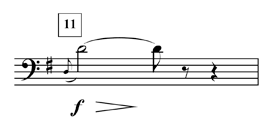 |
Explanatory comment: Here an appoggiatura has been added to the down beat of RN 11 (D-natural) and a diminuendo added between beats 2 and 3. Even though the notes and register are the same in both examples, the clefs are different.
Revision Chart 14
| Category of revision: Note alterations, additions, and deletions, and Revisions of articulation and dynamic markings | |
| Location in score: Allegro maestoso, 3 mm. after RN 11 | |
| 1973 Edition | Revised Version |
 |
 |
Explanatory comment: In this revision there is an appoggiatura added to the down beat at 3 mm. after RN 11 (D-natural). In addition, note that a diminuendo is added between beats 1 and 3, and the clef has been changed.
Revision Chart 15
| Category of revision: Rhythmic alteration, revisions of articulation and dynamic markings, and note alterations, additions, and deletions |
| Location in score: Allegro maestoso, 4 mm. before up to RN 12 |
| 1973 Edition |
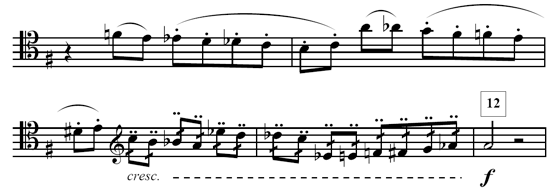 |
| Revised Version |
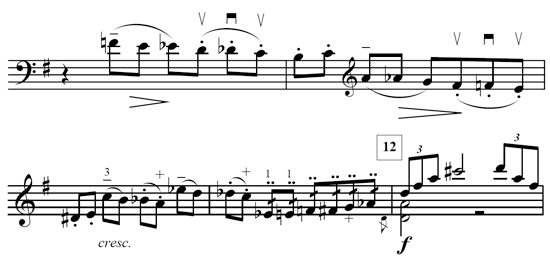 |
Explanatory comment: In this revision changes in articulation and dynamic marks are first introduced at 4 mm. before RN 12. The articulation is changed from the slurring of two eighth-notes of beat 2 of 4 mm. before RN 12 to three eighth-notes in the revised version. At 4 mm. before RN 12 (beats 3 and 4) and in the following measure (beat 1), the six distinct eighth notes are slurred, with staccato markings on top of each note; these six eighth-notes are supposed to be played in one bow. In the revised version there is a change to three slurred eighth-notes with staccato markings, followed by two separated eighth-notes. Similarly, in 3 mm. before RN 12 on beats 2, 3 and 4, and at 2 mm. before RN 12 on beat 1 the same scheme of articulation is applied. In addition, in the revised version, note that at 4 mm. before RN 12 on beat 2, and at 3 mm. before RN 12 on beat 2, a dash is placed on top of each note to change the articulation to a detaché. Changes in the rhythm are first introduced at 2 mm. before RN 12 on beats 2, 3, and 4, and at 1 m. before RN 12 on beat 1. In the 1973 edition the player is supposed to play two sixteenth-notes for every eighth-note with separate articulated bow strokes, while in the revised version only single eighth-notes remain, with slurs and dots as well as dashes placed on specific notes. In addition, dynamic revisions are made at 4 mm. before RN 12, and at 3 mm. before RN 12: a diminuendo from beats 2 to 3 is added in both cases. Even though the notes and register are the same in both examples, the clefs have been changed. Fingerings and bowings have been added to the revised version. Finally, at RN 12 the note d1 has been added to be played as a chord along with the a1. In addition, note that at RN 12 notes from the piano part have been added to the bass part as a guide.
Revision Chart 16
| Category of revision: Note alterations, additions, and deletions, rhythmic alteration, revisions of articulation and dynamic markings | |
| Location in score: Allegro maestoso, 4 mm. before RN 15 | |
| 1973 Edition | Revised Version |
 |
 |
Explanatory comment: Here the first B of the measure is deleted and an eighth-note triplet rest is added to the revised version. Dynamic changes occur on beat 1, with the addition of mezzo forte; on beat 4 a diminuendo is added. Fingerings and bowings are added to the revised version. The harmonic signs (o) on the notes of the first two beats are deleted and instead staccato markings are added.
Revision Chart 17
| Category of revision: Tempo markings, and revisions of articulation and dynamic markings | |
| Location in score: Allegro maestoso, 1 m. before RN 15 | |
| 1973 Edition | Revised Version |
 |
 |
Explanatory comment: in this revision slurs are added for every two beats. As a second choice, staccato articulations are presented in parentheses in the revised version. A rall. (rallentando) is added on beat 3, as well as a diminuendo on beat 4.
Revision Chart 18
| Category of revision: Tempo markings, and revisions of articulation and dynamic markings | |
| Location in score: Allegro maestoso, 2 mm. to 1 m. before RN 16 | |
| 1973 Edition | Revised Version |
 |
 |
Explanatory comment: In this revision a poco accellarando is added, the slurs in beat 1 of each measure are taken off, and dashes are added instead. In the revised version, a portato articulation is added on beat 4 of 1 m. before RN 16. A crescendo is added, stretching from beat 1 to beat 4 at 1 m. before RN 12 with forte at beat 4. Fingerings are also added to the revised version.
Revision Chart 19
| Category of revision: Tempo markings, and revisions of articulation and dynamic markings |
| Location in score: Allegro maestoso, 1 m. before RN 17 to 3 mm. after RN 17 |
| 1973 Edition |
 |
| Revised Version |
 |
Explanatory comment: Here distinct tempo markings are added to the revised version. At 1 m. before RN 17 a Lento is placed on top of the Tempo I, also note the Al is added just before Tempo I, which refers to the initial tempo of the movement. Next, an accell . . . (accelerando) is added at RN 17 and a metronome marking of quarter-note equals 120 added with Tempo at 3 mm. after RN17. In addition, in the revised version a mf replaces the f at 1 m. before RN17, a crescendo at RN17 is added, and an f at 3 mm. after RN17. Fingerings are also added to the revised version. Note that the designation RN 17 is only present in the revised version. In the published 1973 edition RN 17 is missing.
Revision Chart 20
| Category of revision: Revisions of articulation and dynamic markings |
| Location in score: Allegro maestoso, 2 mm. before RN 18 to RN 18 |
| 1973 Edition |
 |
| Revised Version |
 |
Explanatory comment: In this revision the slurs over the triplet figures have been altered at 2 mm. before RN18. Instead of six slurred eighth-note triplets, some eighth-notes triplets have no slurs, e.g., at 2 mm. before RN 18 on beat 3, and on beats 3 and 4 of 1 m. before RN18. In addition, on beat 3 of 2 mm. before RN 18 and on the first two beats of 1 m. before RN18, slurs are put on top of each beat. A crescendo is added from beat 2 to 4 in 1 m. before RN18. Fingerings as well as bowings are also added to the revised version.
Revision Chart 21
| Category of revision: Tempo markings and revisions of articulation and dynamic markings |
| Location in score: Allegro maestoso, RN 20 and 1 m. after RN 20 |
| 1973 Edition |
 |
| Revised Version |
 |
Explanatory comment: In this revision the tempo marking has changed from quarter-note equals 120 at 3 mm. after RN 17 to a Lento at RN 20. An accelerando has been added at beat 2, 1 m. after RN 20. Note that in the last beat of RN 20 the slur has been removed and accents have been added to each sixteenth-note. At 1 m. after RN 20 on the last beat, the slur has been shortened: only the first two sixteenth-notes have the slur, and on top of the last two sixteenth-notes accents have been added. Fingerings are added to the revised version. Note that the word solo at RN 20 has been removed in the revised version.
Revision Chart 22
| Category of revision: Tempo markings and Revisions of articulation and dynamic markings |
| Location in score: Allegro maestoso, 3 to 5 mm. after RN 20 |
| 1973 Edition |
 |
| Revised Version |
 |
Explanatory comment: In this revision the tempo marking has changed from the Lento at RN 20 to quarter-note equals 120 at 3 mm. after RN 20. A Lento (quarter-note equals 52) has been added on beat 4 at 4 mm. after RN 20. In addition, the articulation markings in the last beat of 3 mm. after RN 20 have been changed from vertical accents to staccato markings with accents for each eighth-note triplets; the dotted-half note in the same measure also receives an accent marking as does the first note of 4 mm. after RN20. Note that on the last beats of both 4 and 5 mm. after RN 20 slurs have been added, and in beat 2 of 5 mm. after RN 20 staccato markings have been added. In addition, a decrescendo marking has been added on beats 1 to 4 at 4 mm. after RN20. Fingerings have also been added to the revised version.
Revision Chart 23
| Category of revision: Tempo markings and revisions of articulation and dynamic markings |
| Location in score: Allegro maestoso, Tempo markings and revisions of articulation and dynamic markings |
| 1973 Edition |
 |
| Revised Version |
 |
Explanatory comment: In this revision the accell . . . (accelerando) marking has been added at beat 2, 7 mm. after RN 20. In addition, articulation markings have been placed on beats 2 and 4 at 6 mm. after RN 20: staccato and detaché respectively. Fingerings are also added to the revised version.
Revision Chart 24
| Category of revision: Tempo markings and revisions of articulation and dynamic markings | |
| Location in score: Allegro maestoso, 10 to 11 mm. after RN 20 | |
| 1973 Edition | Revised Version |
 |
 |
Explanatory comment: In this revision the tempo marking has been added to read quarter-note equals 52 (un poco sostenuto) at 10 mm. after RN 20. Articulation markings have been added on beats 3 (a slur) and 4 (detaché) at 10 mm. after RN 20, with an accent marking added on beat 1 at 11 mm. after RN 20. Fingerings and bowings are also added to the revised version.
Revision Chart 25
| Category of revision: Tempo markings | |
| Location in score: Allegro maestoso, 14 to 15 mm. after RN 20 | |
| 1973 Edition | Revised Version |
 |
 |
Explanatory comment: Here fermatas are added on both of the initial eighth-notes at 14 and 15 mm. after RN 20.
Revision Chart 26
| Category of revision: Tempo markings, note alterations, additions, and deletions, rhythmic alteration, revisions of articulation and dynamic markings |
| Location in score: Allegro maestoso, 7 and 8 mm. before RN 21 |
| 1973 Edition |
 |
| Revised Version |
 |
Explanatory comment: In this revision the first E of the measure, at 8 mm. before RN 21 is changed from a dotted-half note to a half note tied to an eighth-note, while in the second half of beat 3 an E-natural is added to the part. This same E is slurred to beat 4 in the same measure. At 7 mm. before RN 21 on beats 3 and 4, the rhythm is changed from sixteenth-notes to four thirty-second notes and an eighth-note rest for each beat. A Lentamente is added in 8 mm. before RN 21 on beat 4, as well as a rall. (rallentando) at 7 mm. before RN 21 beat 3. Also note the arrow in beats 1 and 2 of the same measure. Moreover, a sforzato is added at 8 mm. before RN 21 as well as stress markings (in the first notes of beats 3 and 4 of 7 mm. before RN21). Fingerings are also added to the revised version.
Revision Chart 27
| Category of revision: Tempo markings and revisions of articulation and dynamic markings |
| Location in score: Allegro maestoso, 5 to 4 mm. before RN 21 |
| 1973 Edition |
 |
| Revised Version |
 |
Explanatory comment: In this revision a tempo marking of Lento has been added at 5 mm. before RN 21 and an accell . . . (accelerando) marking has been added at 4 mm. before RN 21. Slurs are placed on top of the first two sixteenth-notes of each beat for both measures. Fingerings are also added to the revised version.
Revision Chart 28
| Category of revision: Revisions of articulation and dynamic markings |
| Location in score: Allegro maestoso, 3 to 2 mm. before RN 21 |
| 1973 Edition |
 |
| Revised Version |
 |
Explanatory comment: In this revision slurs have been added over the first two sixteenth-notes of every beat in both measures. Note that the diminuendo marking at 2 mm. before RN 21 has been removed. Fingerings are also added to the revised version.
Revision Chart 29
| Category of revision: Tempo markings | |
| Location in score: Allegro maestoso, RN 21 | |
| 1973 Edition | Revised Version |
 |
 |
Explanatory comment: Here a tempo marking of quarter-note equals 132 has been added. Note that the word "orchestra" has been spelled out in the revised version.
Revision Chart 30
| Category of revision: Register alteration, and revisions of articulation and dynamic markings |
| Location in score: Allegro maestoso, 4 to 1 mm. before RN 22 |
| 1973 Edition |
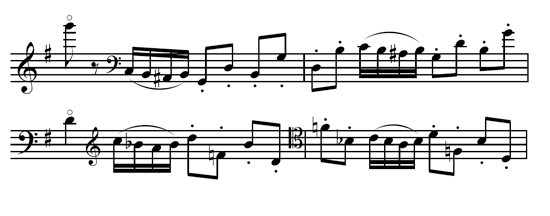 |
| Revised Version |
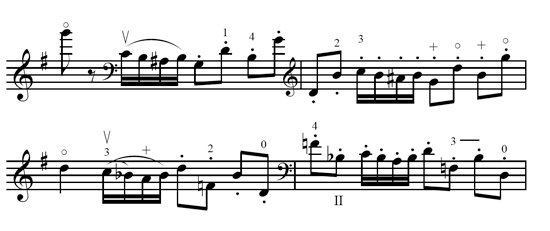 |
Explanatory comment: In this revision, the passage extending from beat 2 after 4 mm. before RN 22 to beat 1 at 2 mm. before RN 22, the register has been shifted one octave higher. In addition, the slurs from beat 2 at 3 and 1 mm. before RN 22 have been removed and staccato markings have been added. Fingerings, as well as bowings, are also added to the revised version.
Revision Chart 31
| Category of revision: Tempo markings | |
| Location in score: Allegro maestoso, 2 mm. after RN 23 | |
| 1973 Edition | Revised Version |
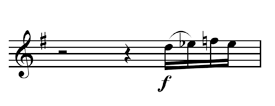 |
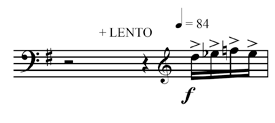 |
Explanatory comment: In this revision a + Lento (più Lento) tempo marking of quarter-note equals 84 has been added, marking a change from quarter-note equals 132 at RN 21. Note that the slur on the first two sixteenth-notes in beat 4 of 2 mm. after RN 23 has been removed and accents have been added over all four sixteenth-notes.
Revision Chart 32
| Category of revision: Tempo markings, note alterations, additions, and deletions, register alteration, and revisions of articulation and dynamic markings |
| Location in score: Allegro maestoso, 6 to 11 mm. after RN 23 |
| 1973 Edition |
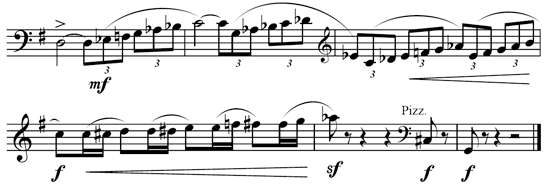 |
| Revised Version |
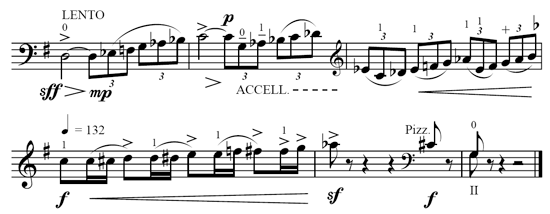 |
Explanatory comment: In this extensive revision a tempo marking of Lento has been added at 6 mm. after RN 23, an accell . . . (accelerando) marking has been added at 7 mm. after RN 23, and a tempo marking of quarter-note equals 132 at 9 mm. after RN 23. In addition, a note has been altered, at 8 mm. after RN 23 on the last eighth-note triplet in the measure: the b1-natural has been changed to b1-flat. Note that the register of last two notes of this excerpt, C-sharp and G-natural, has been moved one octave higher. Articulation markings have also been altered: accents have been added on beat 1 of 7 mm. after RN 23, on beats 2, 3, and 4, as well as the last two sixteenth-notes at 9 mm. after RN 23, as well as on the eighth-note downbeat of 10 mm. after RN 23. Detaché markings have been added on the second and third eighth-note triplets of beat 3 in 7 mm. after RN 23. Slurs have been removed from the following places: between 6 and 7 mm. after RN 23 (B-flat to C), between the second and third eighth-note triplets of beat 3 at 7 mm. after RN 23, between 7 and 8 mm. after RN 23 (D-flat to E-flat, at 8 mm. after RN 23 the slurs are displaced so that every three eighth-note triplet figure receives one slur), and from 9 to 10 mm. after RN 23 in the last two sixteenth-notes to the down beat of the next measure. In addition, a sforzato has been added on the D-natural at 6 mm. after RN 23, a diminuendo is added between beats 1 and 3 of the same measure, and the original mf is changed to a mp on beat 3 of the same measure. At 7 mm. after RN 23 another diminuendo is added between beats 1 and 3. Fingerings are also added to the revised version.
3.2.2 — Marcia
Revision Chart 33
| Category of revision: Tempo markings | |
| Location in score: Title page, beginning of the Marcia | |
| 1973 Edition | Revised Version |
 |
 |
Explanatory comment: The metronome marking of quarter-note equals 138/140 has been added next to Alla marcia, allegramente.
Revision Chart 34
| Category of revision: Register alteration, Revisions of articulation and dynamic markings |
| Location in score: Marcia, 1 m. before RN1 to 6 mm. after RN1 |
| 1973 Edition |
 |
| Revised Version |
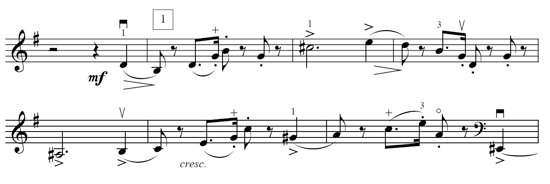 |
Explanatory comment: In this revision the register has been moved one octave higher from 1 m. before RN 1 to beat 2 of 6 mm. after RN 1. Note that beat 3 of 6 mm. after RN 1 is in the original register but a harmonic sign is added. Note that in the revised version the passage is written in treble clef whereas in the 1973 edition it is in bass clef. Articulation markings have been altered: the stress marking on top of the first D-natural in 1 m. before RN 1 has been removed, slurs are inserted at RN 1 (beat 2) and 6 mm. after RN 1 (beat 2), and accent markings have been added on the down beat of 2 mm. after RN 1 (C-sharp) and on the down beat of 4 mm. after RN 1 (A-sharp). In addition, a diminuendo is added from beat 4 of 2 mm. after RN 1 to the down beat of 3 mm. after RN 1. Fingerings and bowings are also added to the revised version.
Revision Chart 35
| Category of revision: Note alterations, additions, and deletions | |
| Location in score: Marcia, RN5 | |
| 1973 Edition | Revised Version |
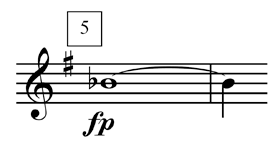 |
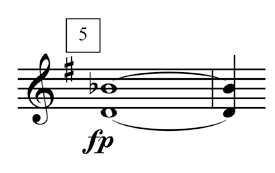 |
Explanatory comment: In this revision a D-natural has been added at RN5.
Revision Chart 36
| Category of revision: Register alteration | |
| Location in score: Marcia, 1 m. before RN 6 | |
| 1973 Edition | Revised Version |
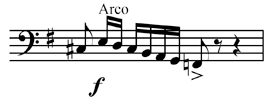 |
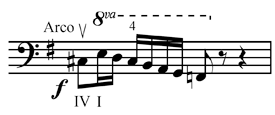 |
Explanatory comment: From the second half of the down beat of 1 m. before RN 6 on, the register has been moved one octave higher. Fingerings are also added to the part.
Revision Chart 37
| Category of revision: Rhythmic alteration and revisions of articulation and dynamic markings | |
| Location in score: Marcia, 7 mm. before RN 8 | |
| 1973 Edition | Revised Version |
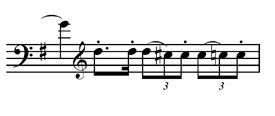 |
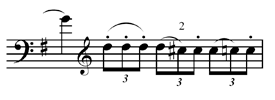 |
Explanatory comment: in this revision the rhythm in beat 2 of 7 mm. before RN 8 has been altered from a dotted-eighth-note plus a sixteenth-note to a three eighth-note triplet. Also note that in the revised version a slur is added on top of beat 2. Finally, fingering has been added to the part.
Revision Chart 38
| Category of revision: Note alterations, additions, and deletions, revisions of articulation and dynamic markings | |
| Location in score: Marcia, 3 and 4 mm. after RN 9 | |
| 1973 Edition | Revised Version |
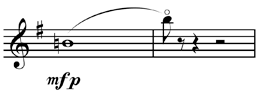 |
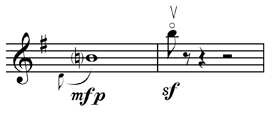 |
Explanatory comment: In this revision an appoggiatura is added at the down beat of 3 mm. after RN 9. Also, a sf is added at 4 mm. after RN 9. Bowings are also added to the revised version.
Revision Chart 39
| Category of revision: Revisions of terms, titles, and special markings |
| Location in score: Marcia, 2 mm. before RN13 to RN131 |
| 1973 Edition |
 |
| Revised Version |
 |
Explanatory comment: In the 1973 edition the word "Arco" is missing at beat 4, 2 mm. before RN 13. Bowings and fingerings are also added to the revised version.
3.2.3 — Aria
Revision Chart 40
| Category of revision: Tempo markings | |
| Location in score: Title page, beginning of the Aria | |
| 1973 Edition | Revised Version |
 |
 |
Explanatory comment: The metronome marking of quarter-note equals 60 has been added next to Andante.
Revision Chart 41
| Category of revision: Tempo markings, and revisions of articulation and dynamic markings |
| Location in score: Aria, 2 to 5 mm. after RN 2 |
| 1973 Edition |
 |
| Revised Version |
 |
Explanatory comment: The tempo markings have been added to the revised version in the following order: at 2 mm. after RN 2 "con passione (libero) free," at 3 mm. after RN 2 "tempo," at 4 mm. after RN 2 "(+ libero) free" has been added, and at 5 mm. after RN 2 a "Tempo." In addition, the following dynamic markings have been added: at 2 mm. after RN 2 on the second half of beat 1 a crescendo marking has been added; a mf has been added on beat 2 of the same measure, and in 4 mm. after RN 2 a mf has been added on the down beat and a crescendo on the second half of beat 4. Articulation markings have also been added to the revised version: stress markings on beat 2 at 2 mm. after RN 2 and at 4 mm. after RN 2. Bowings are also added to the revised version. Note that in the 1973 edition double bars are used to indicate when the time signature changes, while in the revised version these have been removed.
Revision Chart 42
| Category of revision: Tempo markings, and revisions of articulation and dynamic markings |
| Location in score: Aria, 6 to 12 mm. after RN 2 |
| 1973 Edition |
 |
| Revised Version |
 |
Explanatory comment: In this extensive revision tempo markings have been added in the following order: at 6 mm. after RN 2 "(libero) free," at 7 mm. after RN 2 "tempo," at 8 mm. after RN 2 "libero — free," and at 10 mm. after RN 2 a "precipitando." In addition, at 10 mm. after RN 2, a left-oriented arrow on beats 1 and 2 has been added (meaning the music will slow down), as well as a right-oriented arrow from the very end of beat 4, 10 mm. after RN 2 to the first beat of 11 mm. after RN 2. New dynamic markings have been added at 6 mm. after RN 2 on beat 1, a più f; in the second half of beat 4 of the same measure a crescendo marking; at 9 mm. after RN 2 a sf marking on beat 1 and a f marking on beat 3, and at 12 mm. after RN 2 for the second half of beat 2 a crescendo marking has been added. New articulation markings appear in the revised version: stress markings on the first and second half of beat 2 at 6 mm. after RN 2, on the first and second half of beat 2 at 8 mm. after RN 2, on the first note of beat 4 at 10 mm. after RN 2, and at beats 1, 2, and 3 at 11 mm. after RN 2; portato markings are added in the two sixteenth-notes on the second half of beat 2 and 4 at 9 mm. after RN 2; accents have also been added at 7 mm. after RN 2, beats 1 and 3 at 9 mm. after RN 2, on the down beat of 10 mm. after RN 2, and on the four sixteenth-notes of beat 2 at 12 mm. after RN 2. Fingerings are also added to the revised version.
Revision Chart 43
| Category of revision: Tempo markings, note alterations, additions, and deletions, and revisions of articulation and dynamic markings | |
| Location in score: Aria, 1 m. before RN 6 to RN 6 | |
| 1973 Edition | Revised Version |
 |
 |
Explanatory comment: Here a B-flat is added to the down beat of 1 m. before RN 6. Dynamic markings have been added to the revised version: a crescendo is added starting on the second half of beat 2 at 1 m. before RN 6 and a ff is added to the down beat at RN 6. In addition a left-oriented arrow is added on the second half of beat 3 at 1 m. before RN 6. Bowings and fingerings are also added to the revised version. Note that both passages are written in different clefs.
Revision Chart 44
| Category of revision: Register alteration | |
| Location in score: Aria, 1 m. before RN 7 to 2 mm. after RN 7 | |
| 1973 Edition | Revised Version |
 |
 |
Explanatory comment: In this revision of the passage extending from beat 2 of 1 m. before RN 7 to beat 3 of 2 mm. after RN 7 the register has been shifted one octave higher. Bowings and fingerings are also added to the revised version.
3.2.4 — Finale
Revision Chart 45
| Category of revision: Tempo markings | |
| Location in score: Title page, beginning of the Finale | |
| 1973 Edition | Revised Version |
 |
 |
Explanatory comment: The metronome marking of quarter-note equals 132 has been added next to Allegro marcato.
Revision Chart 46
| Category of revision: Register alteration | |
| Location in score: Finale, 4 and 3 mm. before RN 1 | |
| 1973 Edition | Revised Version |
 |
 |
Explanatory comment: In the passage extending from the second half of beat 4 of 4 mm. before RN 1 to beat 2 of 3 mm. before RN 1 the register has been moved one octave higher. Bowings and fingerings have also been added to the revised version.
Revision Chart 47
| Category of revision: Register alteration | |
| Location in score: Finale, at RN 2 | |
| 1973 Edition | Revised Version |
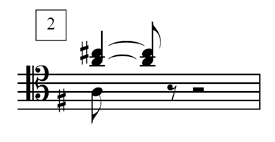 |
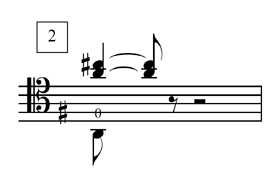 |
Explanatory comment: In this revision the register of the bass note A of the A major chord at RN 2 has been moved one octave lower (to be played on the open string A).
Revision Chart 48
| Category of revision: Tempo markings, revisions of articulation and dynamic markings, and revisions of terms, titles, and special markings | |
| Location in score: Finale, 3 mm. before RN 4 | |
| 1973 Edition | Revised Version |
 |
 |
Explanatory comment: Here a metronome marking of quarter-note equals 88 has been added next to Poco meno. In addition, a ff in the revised version replaces the f of the 1973 edition. Fingerings are also added to the revised version.
Revision Chart 49
| Category of revision: Register alteration, and revisions of articulation and dynamic markings | |
| Location in score: Finale, 3 and 4 mm. after RN 6 | |
| 1973 Edition | Revised Version |
 |
 |
Explanatory comment: In this revision the register in the passage lasting from the second half of beat 4 at 3 mm. after RN 6 to beat 2 at 4 mm. after RN 6 has been shifted one octave higher. A slur has been added on the second half of beat 4 at 3 mm. after RN 6 (two sixteenth-notes). Bowings and fingerings are also added to the revised version.
Revision Chart 50
| Category of revision: Revisions of articulation and dynamic markings, and revisions of terms, titles, and special markings |
| Location in score: Finale, 6 and 5 mm. before RN 8 |
| 1973 Edition |
 |
| Revised Version |
 |
Explanatory comment: Here a repeat sign has been placed at the beginning of the measure, 6 mm. before RN 8. In addition the dynamic marking has been changed from p to mf. Note that a specially played note has been added at 6 mm. before RN 8, together with the marking "2ª p ponticello," indicating that the passage should be played piano and sul-ponticello for the second time. Fingerings have also been added to the revised version.
Revision Chart 51
| Category of revision: Tempo markings, and revisions of articulation and dynamic markings | |
| Location in score: Finale, at 4 mm. after RN 9 | |
| 1973 Edition | Revised Version |
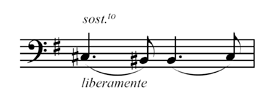 |
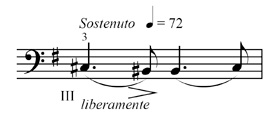 |
Explanatory comment: Here a tempo marking of quarter-note equals 72 has been added at 4 mm after RN 9. A diminuendo on the second half of beat 2 has also been added. Fingerings are also added to the revised version.
Revision Chart 52
| Category of revision: Note alterations, additions, and deletions, and revisions of articulation and dynamic markings |
| Location in score: Finale, 9 to 11 mm. after RN 9 |
| 1973 Edition |
 |
| Revised Version |
 |
Explanatory comment: In this revision the C-flat quarter-note at 9 mm. after RN 9 has been displaced to beat 4 instead of beat 3 as in the 1973 edition. A similar change occurs at 10 mm. after RN 9, where the C-natural quarter-note is displaced from beat 3 to beat 4, and at 11 mm. after RN 9, where a C-sharp quarter-note is added on beat 4. In addition, a crescendo is added at 11 mm. after RN 9 from beat 3 through 4. Fingerings are also added to the revised version.
Revision Chart 53
| Category of revision: Tempo markings, and revisions of articulation and dynamic markings | |
| Location in score: Finale, at 12 mm. after RN 9 | |
| 1973 Edition | Revised Version |
 |
 |
Explanatory comment: Here a lento has been added before the accell . . . (accelerando) on beat 3. A detaché marking is added to the last sixteenth-note of beat 2, and slurs are added on beat 4 for every two sixteenth-notes. A tie is added from the first chord to the first sixteenth-note. Bowings and fingerings are also added to the revised version.
Revision Chart 54
| Category of revision: Revisions of articulation and dynamic markings, and revisions of terms, titles, and special markings | |
| Location in score: Finale, at 14 mm. after RN 9 | |
| 1973 Edition | Revised Version |
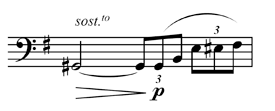 |
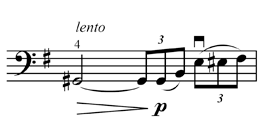 |
Explanatory comment: In this revision the term sost.to (Sostenuto) has been replaced by lento. In addition, the slur over beats 3 and 4 has been replaced by two slurs, one on beat 3 over the last two eighth-notes of that beat's triplet, and the other one on beat 4 over the entire triplet. Bowings are also added to the revised version.
Revision Chart 55
| Category of revision: Tempo markings, and note alterations, additions, and deletions | |
| Location in score: Finale, 11 and 10 mm. before RN 10 | |
| 1973 Edition | Revised Version |
 |
 |
Explanatory comment: In this revision a rall . . . (rallentando) marking has been added at 11 mm. before RN 10, also a tempo marking of quarter-note =58 has been added next to the cantabile at 10 mm. before RN 10. In addition, note that the A-natural quarter-note on the downbeat of 10 mm. before RN 10 has been put in parenthesis, meaning that it is left up to the interpreter to play that note or not. Fingerings are also added to the revised version.
Revision Chart 56
| Category of revision: Tempo markings, Revisions of articulation and dynamic markings | |
| Location in score: Finale, 8 and 7 mm. before RN 10 | |
| 1973 Edition | Revised Version |
 |
 |
Explanatory comment: Here a poco accelerando has been added at 8 mm. before RN 10, and a rall. (rallentando) as well as a crescendo markings have been added at beat 3 through beat 4, respectively, at 7 mm. before RN 10. Fingerings are also added to the revised version.
Revision Chart 57
| Category of revision: Tempo markings, and revisions of articulation and dynamic markings |
| Location in score: Finale, 6 mm. before RN 10 to RN 10 |
| 1973 Edition |
 |
| Revised Version |
 |
Explanatory comment: In this revision a lento has been added in parenthesis next to Sostenuto at 6 mm. before RN 10, this marking goes in accordance with the lento added at 14 mm. after RN 9 (see Revision Chart 51). A Tempo I marking has been added at 1 m. before RN 10. Note that a f as well as a diminuendo to p have been added for the passage extending from the first down-beat (fermata) sixteenth-note to the second sixteenth-note at 6 mm before RN10. Note that even though in the 1973 edition there are only slurs over the two sixteenth-notes of beat 1 at 6 mm. before RN 10, it is understood that throughout the whole section the same articulation should be applied. In the revised version slurs are actually put over every two sixteenth-notes to make the articulation absolutely clear to the interpreter. In addition, note that there are stress markings added at 4 to 2 mm. before RN 10, and accents added at 1 m. before RN 10. Fingerings have also been added to the revised version.
Revision Chart 58
| Category of revision: Revisions of articulation and dynamic markings | |
| Location in score: Finale, 25 and 26 mm. after RN 10 | |
| 1973 Edition | Revised Version |
 |
 |
Explanatory comment: In this revision a pizzicato marking (instead of bowing) has been added at 25 and 26 mm. after RN 10. In addition, a fff as well as accents have been added in the last 3 notes of the passage. Fingerings are also added to the revised version.
3.3 — Concluding Comments on the Revisions
The data and discussions presented in this chapter do indeed reveal that the revision process resulted in numerous and varied changes to the Divertimento. The following paragraphs summarize the most significant revisions found in each of the movements, referenced here by one or more of the revisions categories: tempo markings, note alterations, additions, and deletions, rhythmic alterations, register alterations, as well as revisions of terms, titles, and special markings.
In the Allegro, the most significant revisions can be found in Revisions Charts 2, 3, 4, 5, 7, 8, 9, 11, 12, 13, 14, 15, 16, 19, 21, 22, 24, 25, 26, 27, 29, 30, 31, and 32. A performer's incorporation of these changes will deeply affect the realization of the piece, since they will result in different tempo markings (in Charts 2, 3, 4, 5, 7, 8, 9, 11, 12, 19, 21, 22, 24, 25, 26, 27, 29, 31, and 32), note deletions (in Charts 4, 12, and 16), note additions (in Charts 13, 14, and 26), rhythmic alterations (in Charts 15, 16 and 26), register alterations (in Charts 30 and 32), and note alteration (in Chart 32). In the Marcia, the most significant revisions can be found in Charts 33, 34, 35, 36, 37, and 38. The revisions result in different tempo markings (in Chart 33), register alterations (in Charts 33 and 35), note additions (in Charts 34 and 37), as well as rhythmic alteration (in Chart 36). The revision given in Chart 38 also restores an Arco indication that was missing in the published score. In the Aria, the most significant revisions can be found in Charts 40, 41 and 42. They are concerned with different tempo markings (in Charts 40, 41, and 42), note addition (in Chart 41) and register alteration (in Chart 42). In the Finale, the most significant revisions can be found in Charts 43, 44, 45, 46, 48, 49, 51, 53, 54, 55, and 57. The revisions pertain to different tempo markings (in Charts 45, 48, 51, 53, 54, 55, and 57), register in Charts 43, 44, and 46 and note additions and deletions in Chart 49.
List of Abbreviations and Symbols
2. The Genesis of the Divertimento
3. A Comparison of Both Versions of the Divertimento
For access to the full PDF document of this article, please go to https://getd.libs.uga.edu/view_etd.php?eID=9372.
Ritter Alexandre. "Franco Petracchi and the Divertimento Concertante per Contrabbasso e Orchestra by Nino Rota: A Successful Collaboration Between Composer and Performer." DMA diss., University of Georgia, 2010.
Sarah Lahasky, Editor
Editorial Board
Kathleen Horvath
Andrew Kohn
Shanti Nachtergaele
Fiona M. Palmer
Tae Hong Park
Sonia Ray
Phillip Serna
Usage Guidelines